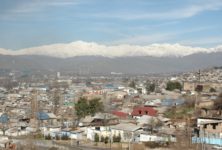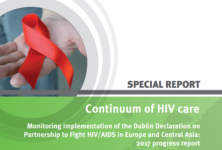People living with HIV are at increased risk for some cancers. This risk arises from several factors, including co-infection with viruses that have the potential to cause cancer, elevated rates of smoking and alcohol use, and ongoing exposure to proteins produced by HIV. Taking anti-HIV therapy (commonly called ART) and achieving and maintaining an undetectable viral load and the ensuing increase in CD4+ cell counts greatly helps to reduce cancer risk.
However, despite the use of ART, HIV still resides in a portion of cells of the immune system in lymph nodes and lymphatic tissues. Such infected cells produce viral proteins and may play a role in inflaming and activating the immune system. Potentially, these residual effects of HIV-infected cells could play a role in cancer risk. As HIV-positive people live longer thanks to ART, research is needed to assess their risk for cancer.
A team of scientists with the large database EuroSIDA have been collecting health-related information from clinics that care for HIV-positive people. The team’s most recent analysis focused on nearly 16,000 people monitored between 2001 and 2012, of whom 610 (about 4%) developed at least one cancer. Over time, the proportion of cancers related to infectious causes decreased while cancers unrelated to infections increased. As HIV-positive people live longer, EuroSIDA expects that there will be more cases of cancer unrelated to infectious causes in the years ahead.
Study details
The EuroSIDA database analyses data from 108 clinics in 33 European countries as well as from clinics in Argentina and Israel. In the present analysis researchers focused on people whose data were captured between January 2001 and June 2012.
Researchers divided cancers into the following two groups:
- infection-related cancers
- infection-unrelated cancers
The researchers listed the following as infection-related cancers:
- Kaposi’s sarcoma (KS) – caused by human herpes virus-8
- non-Hodgkin lymphoma and Hodgkin lymphoma – caused by Epstein-Barr virus
- invasive cervical cancer and cancers of the anus, vulva, vagina, penis, base of the tongue, throat and tonsils – all caused by human papillomavirus
- liver cancer – caused by hepatitis B virus (HBV) or hepatitis C virus (HCV)
- stomach cancer – caused by the bacterium H. pylori
All other cancers were considered unrelated to infections.
Although the EuroSIDA database has information on about 18,000 participants, the study team focused on 15,648 participants on whom it had detailed information for the study of cancer. The average profile of participants in the present analysis, when they entered the study, was as follows:
- 16% were aged 51 years or older
- 73% were men, 27% were women
- 33% currently smoked tobacco
- CD4+ count – 410 CD4+ cells/mm3
- HIV viral load – 123 copies/mL
- 24% had survived an AIDS-related infection
- 23% were co-infected with HCV
- 6% were co-infected with HBV
Results—Distribution of cancers
In total, 610 people (4%) developed 643 new cases of cancer during the study period. These cancers were distributed as follows:
- infection-related cancers – 60%
- infection-unrelated cancers – 40%
Researchers stated that the “most common” infection-related cancers were as follows:
- non-Hodgkin lymphoma – 116 cases
- anal cancer – 85 cases
- KS – 62 cases
- Hodgkin lymphoma – 43 cases
According to the researchers, “common” infection-unrelated cancers included the following:
- lung cancer – 55 cases
- prostate cancer – 28 cases
- colorectal cancer – 23 cases
- breast cancer – 22 cases
The research team found that people who developed infection-unrelated cancers tended to be older (the average age was 54 years) and had higher CD4+ counts and lower viral loads than people who developed infection-related cancers.
Age and infection-related cancers
Taking many factors into account, researchers found that overall, people 51 years and older had 12% more infection-related cancers than people aged 36 to 40 years. The factors strongly associated with this increased risk were as follows:
- having a viral load greater than 400 copies/mL. If the viral load was less than 400 copies/mL, the risk for infection-related cancers was greatly diminished. However, having a viral load greater than 400 copies was a major risk factor, responsible for a 19% increase in infection-related cancers among people aged 51 and older. It is unlikely that such cancers would have developed had the viral load been less than 400 copies/mL
- low CD4+ cell counts. People who had less than 500 CD4+ cells had an elevated risk for developing infection-related cancers (regardless of age). For instance, those with less than 200 cells/mm3 developed 21% of infection-related cancers reported in EuroSIDA. People who had between 200 and 349 cells/mm3 developed 11% of infection-related cancers.
Age and infection-unrelated cancers
Overall, researchers found that for every decade in age beyond the 36-to-40-year category, the risk for cancers unrelated to infections doubled.
Among people who smoked, the risk of cancer unrelated to infection (chiefly lung cancer) was elevated in those aged 50 and older.
Forecasting trends
The EuroSIDA researchers noted that a trend emerged in the first half of 2009. That year, cancers unrelated to infections became the main type of cancer diagnosed. The researchers expect that cancers unrelated to infections will gradually increase in the foreseeable future for at least the following reasons:
- aging
- smoking is relatively common among HIV-positive people and this increases the risk for lung cancer
The researchers did not forecast any change in the rate of cancers related to infections among people who injected street drugs. The lack of change in cancer rates in this population may arise because insufficient proportions of people who inject street drugs are receiving the psycho-social and other support necessary to manage their addiction, initiate ART and stay in HIV care (and in some cases in HBV- and HCV-related care too).
For the future
The EuroSIDA team urges clinics and research funding agencies to make infection-related cancers “a priority” in the coming years as higher proportions of HIV-positive people live past 50, 60 and 70 years. The team encourages clinics to “consider undertaking studies evaluating the cost-benefit of [cancer] screening programs for HIV-positive people and targeted preventive interventions such as cessation programs for smoking and alcohol use and vaccination [against cancer-causing viruses]…to reduce the burden of avoidable cancers in the long-term.”
By Sean R. Hosein
REFERENCES:
- Shepherd L, Borges Á, Ledergerber B, et al. Infection-related and -unrelated malignancies, HIV and the aging population. HIV Medicine. 2016; in press.
- Dolcetti R, Giagulli C, He W, et al. Role of HIV-1 matrix protein p17 variants in lymphoma pathogenesis. Proceedings of the National Academy of Sciences USA. 2015 Nov 17;112(46):14331-6.
- Lorenzo-Redondo R, Fryer HR, Bedford T, et al. Persistent HIV-1 replication maintains the tissue reservoir during therapy. Nature. 2016 Feb 4;530(7588):51-6.
- Fletcher CV, Staskus K, Wietgrefe SW, et al. Persistent HIV-1 replication is associated with lower antiretroviral drug concentrations in lymphatic tissues. Proceedings of the National Academy of Sciences USA. 2014 Feb 11;111(6):2307-12.


 ПОИСК ПО САЙТУ
ПОИСК ПО САЙТУ  поиск по ресурсному центру
поиск по ресурсному центру 


